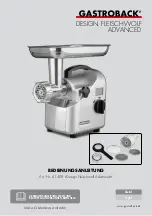
9
9
26.
Never leave machine running unattended. TURN POWER OFF
. Don’t leave machine until
it comes to a complete stop.
27.
Do not
operate this grinder if the gap between a moving belt, wheel or disc, and the work
support surface exceeds 0.118" (3mm).
28.
Minimum Stock Dimensions
.
DO NOT
sand material thinner than 1/16” (1.58mm),
narrower than 1/8” (3.175mm), or shorter than 8” (203mm).
29.
Changing Sanding Belt. DO NOT
operate the sander if the belt is damaged or badly worn.
Replace at once.
30.
Do Not Use Damaged Belts.
Belts that show signs of wear or are torn should be replaced
before continuing use.
31.
Install Belts in Correct Direction.
Install belts with the arrows on the back of the belt facing
the correct direction. Belts with a lap joint must be mounted facing the correct direction. Use
abrasive belts of proper size.
32.
AVOID USING DIRECTIONAL BELTS.
Using belts with a butt joint will outperform belts that
have a lap joint and also do not require directional installation. Lap joint style belts are prone
to separation.
33.
Inspect Piece Part.
Always inspect piece part for staples, nails, knots, or other
imperfections that could become projectiles causing personal injury.
34.
Correctly Feeding The Stock.
Grasp the piece part firmly with both hands and ease into the
belt with light pressure.
NEVER
force the piece part into the belt.
DO NOT
sand tapered or
pointed stock with the point facing into the feed direction of the belt.
NEVER
sand more than
one piece of stock at a time.
35.
Avoid Contact With The Belt.
The abrasive belt when running is an aggressive cutting tool.
Extra care should be exercised when using coarse grit belts due to their rapid cutting action.
36. Bolt this grinder securely to the stand ensuring that the stand is bolted to a stable surface to
stop it from tipping over or moving when in use.
37.
Sharpen Cutting Tools In Proper Direction.
Always sharpen cutting tools especially
knives, scissors, chisels, etc. with the cutting edge facing downwards and in the direction of
rotation of the belt.
NEVER
face the cutting edge upward against the rotation of the belt; this
can result in injury.
38.
Hold Material Tightly.
Always hold the work piece firmly when grinding and apply light and
steady pressure against the abrasive belt.
39.
Never Use The Back Of The Large Drive Wheel.
Using the back of the large drive wheel
will cause debris to travel upwards and contact operator or bystanders.
40.
Keep the grinder properly maintained.
Ensure contact wheels and drive wheels are in
good condition and are free from cuts or splits that can be a danger in operation. Replace all
damaged contact wheels before operating machine.
41.
Turn off
power before checking, cleaning, or replacing any parts.
Summary of Contents for BG-248-2
Page 26: ...24 24 PARTS DIAGRAM...
Page 31: ...29 29 NOTES...












































